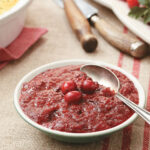When I was a child, I had an intriguing encounter with tomato sauce that I just couldn’t recreate at home. It all started when my family and I dined at a quaint restaurant, and I had a plate of pasta with the most delicious tomato sauce I had ever tasted. The flavour was unlike any other sauce I’d encountered, and I found myself longing for it each time we went out to eat.
Back at home, I attempted to replicate that magical tomato sauce, but no matter how hard I tried, I couldn’t capture its unique taste. This was a time before the internet was as accessible as it is today, and I had no way of finding the restaurant’s recipe. I was stuck with a longing for that elusive tomato sauce, making regular trips to the restaurant my only solution.
I couldn’t help but wonder what made that tomato sauce so exceptional. Was it a secret ingredient? A special cooking technique? Or perhaps it was just the ambiance of the restaurant that made it taste so extraordinary. Regardless, my determination to unravel the mystery of that tomato sauce never waned.
As years passed, I continued to frequent the restaurant, ordering the same dish and savouring each bite of the sauce. I even struck up a conversation with the chef, hoping to uncover some hints. Alas, the recipe remained a well-guarded secret.
Fast forward to my adult years, and the internet had become a treasure trove of culinary knowledge. With a newfound resource at my disposal, I scoured the web for tomato sauce recipes that might resemble the one from that cherished restaurant. I tried different variations, experimented with various ingredients, and honed my cooking skills.
After numerous attempts and adjustments, I finally managed to create a tomato sauce that, while not an exact replica, brought me close to that unforgettable taste.
Barbecue is a cooking tradition beloved by many, and its deliciousness owes much to a key ingredient: tomato sauce. In this article, we will delve into the world of barbecue tomato sauce, exploring its history, ingredients, and regional differences.
The History and Evolution of Barbecue Tomato Sauce
As we know it today, barbecue is a splendid fusion of smoke, fire, and sauce, with the history of the latter being a rich story waiting to be unveiled.
Native American tribes in the Americas were among the earliest to experiment with various tomato-based concoctions, often using wild tomatoes native to the Americas. These early sauces typically incorporated spices and, in some cases, regional ingredients that highlighted unique flavors from specific areas.
When European colonizers ventured across the Atlantic, they encountered these novel sauces and promptly integrated them into their own culinary traditions. The introduction of new ingredients such as sugar, vinegar, and exotic spices elevated the complexity of the sauce to a new level.
Over the centuries, barbecue sauce continued to evolve with the development of global spice trade. Spices from Asia, Africa, and the Middle East became integrated, expanding the palate choices for barbecue enthusiasts. This exchange of culinary traditions continues to influence the evolution of barbecue sauce, resulting in more unique and diverse recipes.
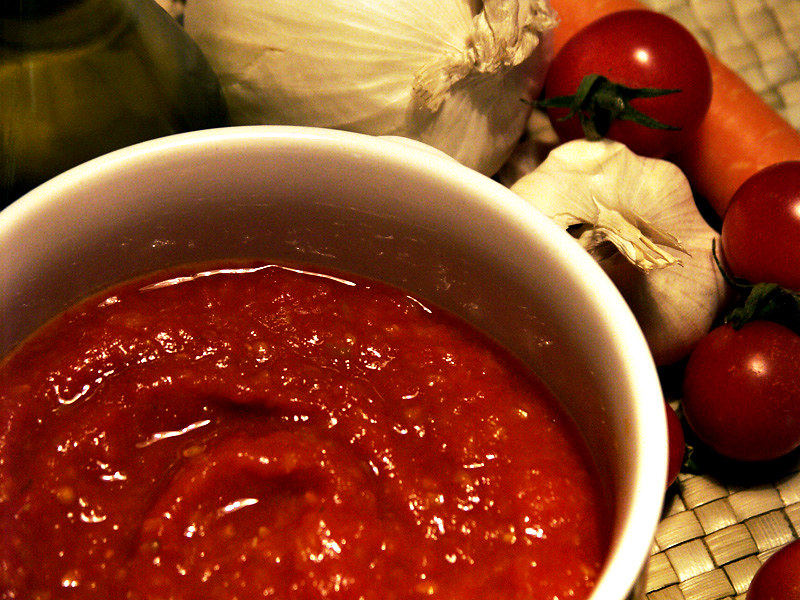
Basic Ingredients for Homemade Barbecue Tomato Sauce
Making homemade barbecue tomato sauce is a rewarding culinary endeavor, allowing you to tailor the sauce to your taste preferences. The core of this effort lies in the selection of basic ingredients, each contributing to the sauce’s distinctive characteristics.
1) Tomatoes: Tomatoes take center stage, providing the sauce with its iconic rich base. Choose ripe, high-quality tomatoes – you can opt for canned, fresh, or even smoked fire-roasted tomatoes. The tomato variety you choose will also impact the overall flavor of the sauce; Roma tomatoes are widely used for their dense flesh and lower water content.
2) Sweetener: Sugar is a key ingredient for balancing the acidity of tomatoes and adding a pleasing sweetness. You can use brown sugar, molasses, honey, or maple syrup. The choice of sweetener contributes to the depth of the sauce’s flavor – brown sugar provides a caramel-like richness, while molasses imparts a deeper smoky sweetness.
3) Vinegar: Vinegar adds acidity and complexity to the sauce. Apple cider vinegar is commonly used, but you can also experiment with red wine vinegar or white vinegar. The type of vinegar can significantly influence the overall flavor of the sauce – apple cider vinegar adds a fruity note, while white vinegar imparts a more robust taste.
4) Spices and Seasonings: The aromatic blend of spices and seasonings is where the real magic happens. You can choose from various spices like garlic, onions, chili powder, cumin, paprika, and more. Each spice emits unique aromas, from smokiness to heat. Balancing these spices is key to achieving the perfect flavor.
5) Salt: Salt plays a crucial role in enhancing the other flavors in the sauce. It helps accentuate the sweetness of sugar, the acidity of vinegar, and the complexity of the spices. Be mindful of the amount of salt, as too much can overpower the sauce’s taste.
6) Fat: Some recipes include a source of fat, such as butter or oil. This adds richness and creaminess to the sauce, helping it meld with other ingredients and create a smooth, luscious texture.
7) Liquid: In addition to tomatoes and vinegar, you can use other liquids to adjust the sauce’s thickness. These may include water, broth, or even juice. Liquid allows you to control the sauce’s consistency and texture according to your preference, making it thick and pourable or thin and pourable.
Classic Barbecue Tomato Sauce Recipes
No barbecue tomato sauce journey is complete without exploring some time-tested classic recipes. Whether you’re planning a barbecue gathering or simply craving nostalgic flavors, these two iconic barbecue tomato sauce recipes will transport your taste buds to a smoky, rich, and irresistible destination.
Recipe One: Traditional Southern Barbecue Tomato Sauce
This tomato sauce recipe is the heart and soul of Southern barbecue, a long-standing culinary tradition that embodies the essence of comfort food. Its origins can be traced to the American South, where barbecue pitmasters have been perfecting this sweet, rich sauce for generations. Here’s how to make this iconic sauce:
Ingredients:
2 cups tomato sauce
1/2 cup apple cider vinegar
1/4 cup brown sugar
2 tablespoons Worcestershire sauce
1 tablespoon Dijon mustard
2 teaspoons chili powder
1 teaspoon garlic powder
1 teaspoon onion powder
1/2 teaspoon cayenne pepper (adjust to taste)
Salt and freshly ground black pepper to taste
Instructions:
In a saucepan, combine tomato sauce, apple cider vinegar, brown sugar, and Worcestershire sauce over medium heat.
Add Dijon mustard, chili powder, garlic powder, onion powder, and cayenne pepper.
Season the sauce with a pinch of salt and a generous amount of freshly ground black pepper.
Simmer the mixture over low heat for about 10-15 minutes, stirring occasionally, until the sauce thickens to your desired consistency.
Taste the sauce and adjust sweetness, richness, or spiciness by adding more brown sugar, vinegar, or cayenne to meet your preference.
This traditional Southern barbecue tomato sauce is a harmonious blend of sweetness and tang with a subtle kick of heat. Its versatility makes it a perfect complement to ribs, pulled pork, or grilled chicken.
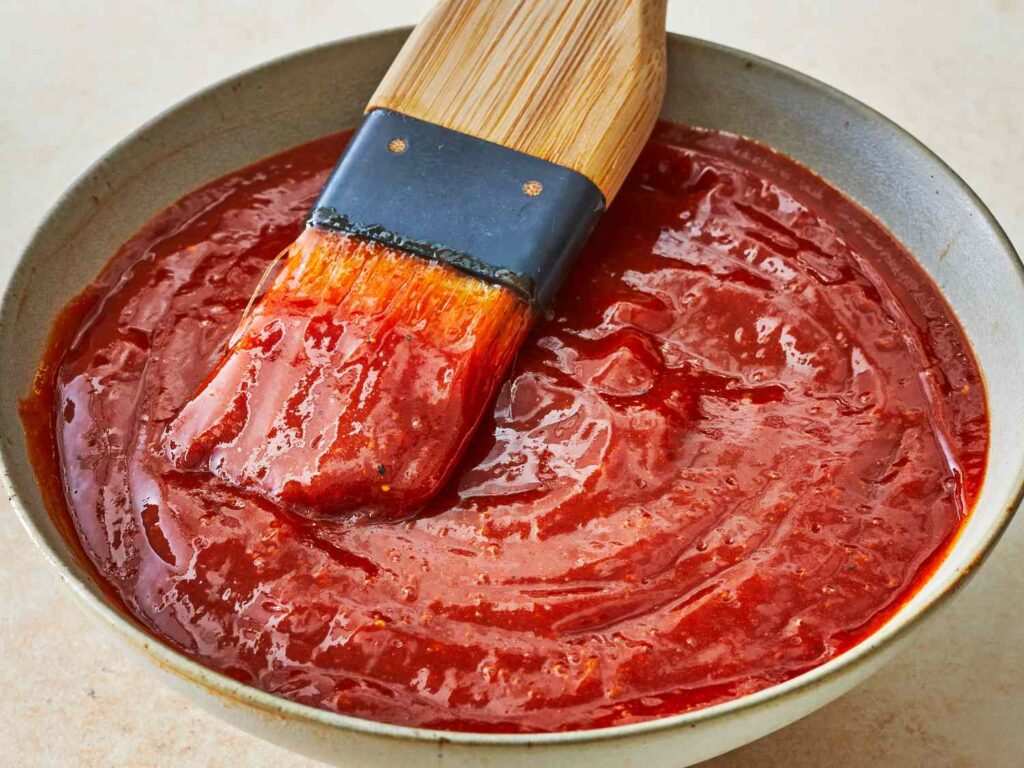
Recipe Two: Kansas City-Style Tomato Molasses Barbecue Sauce
Kansas City is renowned for its barbecue culture and has its unique take on tomato sauce – rich, thick, and featuring molasses. This recipe adds a smoky sweetness to your barbecue dishes. Here’s how to make Kansas City-style tomato molasses barbecue sauce:
Ingredients:
2 cups tomato sauce
1/2 cup molasses
1/4 cup apple cider vinegar
1/4 cup brown sugar
2 tablespoons Worcestershire sauce
1 tablespoon onion powder
1 tablespoon garlic powder
1 teaspoon chili powder
1 teaspoon black pepper
1/2 teaspoon salt
1/2 teaspoon cayenne pepper (adjust to taste)
Instructions:
In a saucepan, combine tomato sauce, molasses, apple cider vinegar, brown sugar, and Worcestershire sauce over medium heat.
Add onion powder, garlic powder, chili powder, black pepper, salt, and cayenne pepper.
Simmer the mixture over low heat for about 15-20 minutes, stirring occasionally, until the sauce thickens and develops a deep, rich color.
Taste the sauce and adjust sweetness, richness, or spiciness by adding more molasses, vinegar, or cayenne to suit your preference.
Kansas City-style tomato molasses barbecue sauce is rich and sweet, with a pronounced smoky flavor, making it an excellent accompaniment to beef, pork, or even grilled vegetables. Its sweet and viscous texture makes it perfect for brushing on ribs and brisket.
Regional Differences in Barbecue Tomato Sauce
One delightful aspect of barbecue culture is its regional diversity, and a significant part of this diversity lies in the variations of barbecue tomato sauce.
1) Carolina Mustard Barbecue Sauce
Carolina barbecue is famous for its tangy mustard-based sauce. This golden-hued condiment is characterized by a robust combination of mustard, vinegar, and a hint of sweetness, often coming from brown sugar or honey. This sauce pairs perfectly with smoked pork, especially pulled pork, delivering a memorable tangy and spicy flavor.
2) Texas Spicy Tomato Sauce
In the Lone Star State, they take their barbecue seriously, and this seriousness extends to their sauce. Texas-style tomato sauce is renowned for its robust peppery flavor. This sauce consists of tomatoes, vinegar, and a blend of bold spices, creating a fiery complement to dishes like beef brisket and smoked sausages. It’s a perfect match for those craving a spicy barbecue experience.
3) Alabama White Barbecue Sauce
Venture deep into the heartland of the South, and you’ll encounter the unique white barbecue sauce of Alabama. This sauce boldly departs from traditional tomato-based sauces and instead uses mayonnaise as its primary ingredient. It’s seasoned with vinegar, black pepper, and a touch of horseradish. White sauce is primarily used to accompany smoked chicken, creating a delightful contrast with its creamy taste against the smoky meat.
4) Memphis Tomato Vinegar Barbecue Sauce
Memphis, known for its juicy ribs, has a tomato vinegar barbecue sauce that strikes a balance between richness and sweetness. This variant typically includes tomato sauce, vinegar, and a blend of spices. The addition of brown sugar or molasses imparts a pleasing sweetness. Memphis tomato vinegar sauce is a wonderful accompaniment to ribs, offering a harmonious fusion of flavors.
These are just a few examples of regional differences in the United States. Each variation showcases how local ingredients, traditions, and preferences shape barbecue culture. However, the diversity of barbecue tomato sauce isn’t limited to the United States.
5) International Flavours and Influences
Beyond the United States, the concept of tomato barbecue sauce has been embraced worldwide. For instance, in the Caribbean, the fusion of local spices and tropical fruits results in vibrant and hearty sauces, perfect for tropical climates and lifestyles. In South America, barbecue enthusiasts often add hot chili peppers to their sauces, creating a unique and mouthwatering spiciness.
Storing and Preserving Barbecue Tomato Sauce
Once you’ve carefully crafted homemade barbecue tomato sauce, understanding how to store and preserve it is crucial. Proper storage not only ensures the sauce’s shelf life but also maintains its quality and flavor.
Refrigeration: If you’ve made your own barbecue tomato sauce or opened a store-bought bottle, the first step is to transfer it into a clean, airtight container or jar. Ensure that the container is designed for food storage. Once the sauce is securely stored, place it in the refrigerator. Proper refrigeration is key to preserving freshness. Unopened store-bought sauce bottles can typically be stored in the pantry until opened.
Airtight Container: Ensure the container is airtight to prevent air from entering. Exposure to air can lead to oxidation, which may alter the sauce’s taste and color. Check for leaks or gaps in the lid, as a secure seal is crucial.
Label and Date: It’s a good practice to label the container with the preparation date or the date the store-bought bottle was opened. This simple step will help you track freshness and avoid using sauce that has been stored for too long.
If you anticipate using the sauce in small quantities, consider portioning it into smaller containers before storing. This can minimize the need to repeatedly expose the entire batch of sauce to air and the potential for spoilage.
For those looking to store large quantities of homemade barbecue tomato sauce for the long term, canning and preservation methods can be highly effective. Here are some tips to consider:
Water Bath Canning: This method involves packing hot tomato sauce into sterilized jars, ensuring proper headspace, sealing the jars, and then processing them in a boiling water bath. The heat kills any microorganisms and creates a vacuum seal, allowing the sauce to be safely stored for up to a year or more.
Pressure Canning: Suitable for low-acid tomato sauces, pressure canning uses special jars to achieve higher temperatures than water bath canning. This ensures that harmful bacteria are killed, enabling the safe long-term storage of the sauce.
Freezing: Freezing is an excellent option for preserving homemade barbecue tomato sauce. Store the sauce in a sealed, freezer-safe container, leaving some space at the top to allow for expansion. Frozen sauce can maintain its quality for up to six months or longer.
Before using any stored sauce, check for signs of spoilage. Look for changes in color, unusual odors, or any mold growth. If the sauce appears or smells off, it should be discarded.
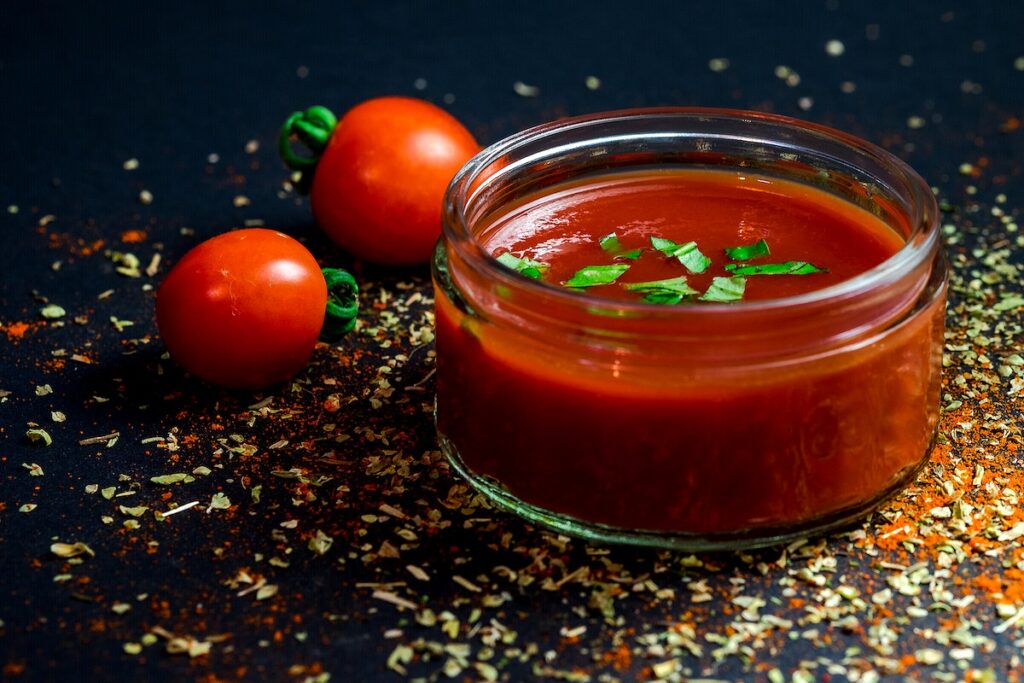
Perfect Pairings: Barbecue Dishes and Tomato Sauce
When it comes to the world of barbecue, the relationship between barbecue dishes and tomato sauce is a time-tested culinary romance. The rich, robust, and sometimes even spicy qualities of tomato sauce complement the smoky, tender, and often charred meats of barbecue perfectly. This pairing is a match made in culinary heaven that has delighted generations of taste buds.
Barbecue Meats and the Ideal Tomato Sauce Pairing:
Pulled Pork and Sweet Tomato Sauce: Slow-cooked pulled pork is best paired with sweet tomato sauce. The sauce’s sweetness balances the savory, smoky flavors of the meat, creating a harmonious flavor combination. In the world of barbecue, this combination is a classic Southern tradition.
Ribs and Rich Tomato Vinegar Sauce: Juicy ribs, whether baby back or spare ribs, thrive under the embrace of a rich tomato vinegar sauce. The sauce’s acidity and slight sweetness soften the richness of the meat, leaving a delightful tingle on the palate.
Beef Brisket and Spicy Tomato Sauce: For the rich, marbled goodness of beef brisket, a spicy tomato sauce is the ideal partner. The sauce’s heat and robust flavor enhance the meat’s natural smokiness, creating a cooking experience that’s both fiery and satisfying.
Grilled Chicken and Smoky Barbecue Sauce: When grilling chicken, smoky barbecue sauce is the perfect companion. The sauce’s smoky richness complements the mild flavor of chicken, forming a pleasing contrast that elevates the dish.
Side Dishes to Pair with Barbecue Tomato Sauce:
Coleslaw: Creamy and crunchy coleslaw is a classic side dish for barbecue. Its cool and creamy flavors provide a sharp contrast to the smoky meat and sauce. When paired with creamy mayonnaise-based dressing, coleslaw offers the perfect balance.
Cornbread: Sweet and crumbly cornbread pairs perfectly with tomato barbecue sauce. The fusion of textures and flavors – the sauce’s richness and the natural sweetness of cornbread – is a delightful combination.
Baked Beans: Baked beans, with their hearty and rich character, complement the sweetness and smokiness of barbecue sauce. Baked beans often contain ingredients like brown sugar, molasses, and bacon, which harmonize beautifully with the sauce’s flavors.
Potato Salad: Potato salad boasts a creamy, salty quality, serving as a side dish to offset the richness or spiciness of the sauce. The gentle starchy potatoes provide the perfect balance to the intensity of the barbecue.
Recommended Beverages for the Complete Barbecue Experience:
Iced Tea: Iced tea is a classic choice for a barbecue feast, offering a refreshing and slightly sweet respite from the smoky meats and spicy sauce. A squeeze of lemon can enhance the experience.
Beer: Many beer varieties, from light lagers to robust stouts, can pair well with barbecue dishes. The choice depends on personal preference, but the carbonation and various flavors in beer help cut through the richness of the food.
Hard Cider: Crisp, fruity hard cider creates a pleasant contrast with the smoky and spicy flavors of barbecue. The subtle sweetness of apple cider complements the sauce’s flavor harmoniously.
Soda: For a non-alcoholic option, soda, especially cola or root beer, is a nostalgic and popular choice. Its effervescence and sweetness make it an ideal match for the bold barbecue flavors.
Conclusion: The Timeless Influence of Tomato Sauce on Barbecue
As we conclude this delicious journey, we hope you’ve now gained a good understanding of the art of mastering barbecue tomato sauce. Its history, ingredients, recipes, and regional variations have been unveiled. Whether you’re a barbecue enthusiast or a curious beginner, tomato sauce is your passport to the world of delicious barbecue experiences.
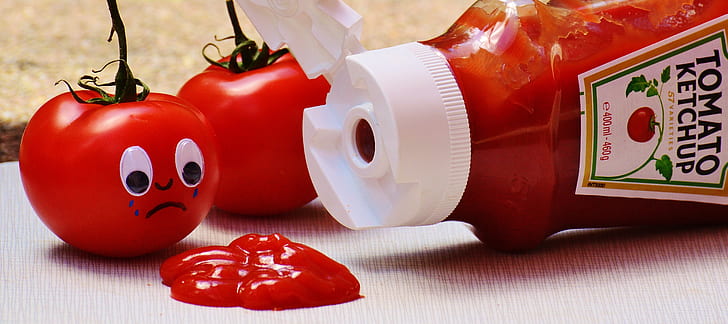
FAQ Section
Q1: Can I make barbecue tomato sauce without sugar?
Absolutely! You can use substitutes such as honey, maple syrup, or agave nectar in place of sugar to create a sugar-free or reduced-sugar version.
Q2: How long can homemade barbecue tomato sauce be stored?
If stored correctly in a sealed container in the refrigerator, homemade barbecue tomato sauce can be kept for up to one month. For longer storage, consider canning or freezing.
Q3: What’s the best tomato sauce for pork barbecue?
For pork, sweet and smoky sauce works very well. Kansas City-style or Memphis tomato vinegar barbecue sauce pairs perfectly with pork.
Q4: How can I make my barbecue tomato sauce spicier?
To make your sauce spicier, you can add ingredients like chili peppers, red pepper flakes, or hot sauce. Start with a little and gradually taste until you achieve your desired level of heat.
Q5: Can I use green tomatoes in barbecue sauce?
Green tomatoes can add a unique, rich flavour to your sauce. If you decide to use them, make sure to balance their acidity with other sweet and savory elements.
Q6: Are there any healthy barbecue tomato sauce options?
Certainly. You can make a healthier barbecue sauce by reducing sugar content and using low-sodium ingredients. Additionally, many commercial brands offer low-sugar or low-sodium barbecue sauces.
Q7: Can I use barbecue tomato sauce as a marinade?
Absolutely! Barbecue tomato sauce is great as a marinade to infuse flavour and moisture into your meats. Be sure to marinate the meat for an adequate amount of time for the best results.
Q8: What’s the secret to achieving a smooth, glossy barbecue sauce?
To achieve that mouthwatering gloss, brush on a final layer of sauce in the last few minutes of cooking. The sugar in the sauce will caramelize, providing a delightful glaze to your barbecue.











